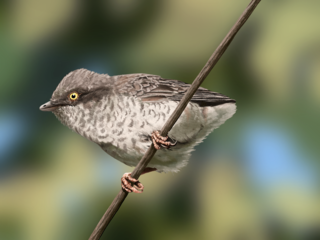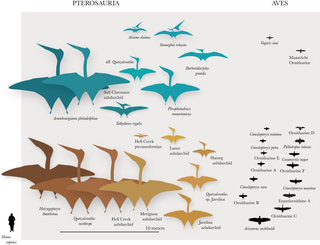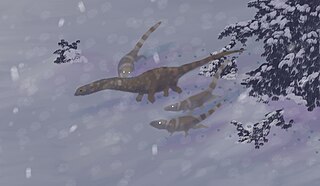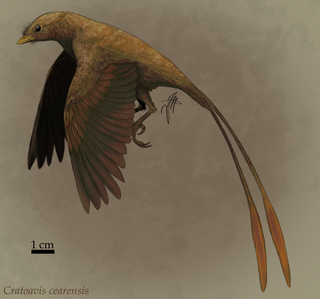
The Enantiornithes, also known as enantiornithines or enantiornitheans in literature, are a group of extinct avialans, the most abundant and diverse group known from the Mesozoic era. Almost all retained teeth and clawed fingers on each wing, but otherwise looked much like modern birds externally. Over eighty species of Enantiornithes have been named, but some names represent only single bones, so it is likely that not all are valid. The Enantiornithes became extinct at the Cretaceous–Paleogene boundary, along with Hesperornithes and all other non-avian dinosaurs.

Avisaurus is a genus of enantiornithine bird from the Late Cretaceous of North America.

Alexornis is a genus of enantiornithine birds from the Bocana Roja Formation of Baja California, Mexico. This geological formation has been dated to the late Cretaceous period, and more specifically to the Campanian age, about 73 mya. The type and only known species is Alexornis antecedens. Its name means "Alex's ancestral bird"; Alexornis from the given name of ornithologist Alexander Wetmore + Ancient Greek ornis, "bird", and antecedens, Latin for "going before" or "ancestral".
Incolornis is an extinct genus of basal birds from the Late Cretaceous. Remains have been found in the Bissekty Formation in Uzbekistan. It is only known from fragmentary coracoids. The systematic position of the genus is unclear; it might have been an enantiornithine bird.

Lectavis is a genus of enantiornithine birds. Their fossil bones have been recovered from the Late Cretaceous Lecho Formation at estancia El Brete, Argentina. The genus contains a single species, Lectavis bretincola.
Gurilynia is a genus of enantiornithine birds. One species is known, G. nessovi. It lived during the Maastrichtian stage of the Late Cretaceous period, between 70 and 66 mya. Gurilynia is known from fragmentary fossils found at the Gurilyn Tsav locality of the Nemegt Formation in south Gobi, Mongolia.
Neuquenornis volans is a species of enantiornithean birds which lived during the late Cretaceous period in today's Patagonia, Argentina. It is the only known species of the genus Neuquenornis. Its fossils were found in the Santonian Bajo de la Carpa Formation, dating from about 85-83 million years ago. This was a sizeable bird for its time, with a tarsometatarsus 46.8mm long. Informal estimates suggest that it measured nearly 30 cm (12 in) in length excluding the tail.

Palintropus is a prehistoric bird genus from the Late Cretaceous. A single species has been named based on a proximal coracoid from the Lance Formation of Wyoming, dated to the latest Maastrichtian, 66 million years ago. Coracoids and a proximal scapula of two unnamed species from the upper Campanian Dinosaur Park Formation of Alberta, dating to between 76.5 and 75 million years ago, are also known.

Dongbeititan is a genus of sauropod dinosaur from the Early Cretaceous-age Yixian Formation of Beipiao, Liaoning, China. It is based on holotype DNHM D2867, a partial postcranial skeleton including bones from the limbs, shoulder and pelvic girdles, and vertebrae, which was described in 2007. Its describers suggested it was as a basal titanosauriform, not as derived as Gobititan or Jiutaisaurus, but more derived than Euhelopus, Fusuisaurus, and Huanghetitan. The type species is D. dongi, and it is the first named sauropod from the Yixian Formation, which is part of the well-known Jehol Group. The genus name refers to the region Dongbei and to Greek titan, "giant". The specific name honours the Chinese paleontologist Dong Zhiming. Like other sauropods, Dongbeititan would have been a large quadrupedal herbivore.

Avisauridae is a family of extinct enantiornithine dinosaurs from the Cretaceous period, distinguished by several features of their ankle bones. Depending on the definition used, Avisauridae is either a broad and widespread group of advanced enantiornithines, or a small family within that group, restricted to species from the Late Cretaceous of North and South America.
Soroavisaurus is a genus of enantiornithean birds related to Avisaurus. It lived during the Late Cretaceous of Argentina. The only known species, S. australis, is known from fossils collected from the Lecho Formation of Estancia El Brete, in the southern tip of the province of Salta, Argentina. A binominal name of this animal means "Southern sister Avisaur".

Longipterygidae is a family of early enantiornithean avialans from the Early Cretaceous epoch of China. All known specimens come from the Jiufotang Formation and Yixian Formation, dating to the early Aptian age, 125-120 million years ago.
Elbretornis is an extinct genus of enantiornithine which existed in what is now Salta Province, Argentina during the late Cretaceous period.
Martinavis is a genus of enantiornithine birds which existed in what is now southern France, North America and Salta Province, Argentina during the late Cretaceous period. It was named by Cyril A. Walker, Eric Buffetaut and Gareth J. Dyke in 2007, and the type species is Martinavis cruzyensis.

Cratoavis is a genus of enantiornithines. The type and only currently described species is C. cearensis, from the Early Cretaceous of Araripe Basin, Ceará, Brazil. The fossil, an articulated skeleton with feathers attached to the wings and surrounding the body, extends considerably the temporal record of the group at South America.

Zhongjianosaurus is a genus of dromaeosaurid belonging to the Microraptoria. Believed to hail from the Yixian Formation, specifically the middle of the Jehol Biota, it is the smallest known microraptorine thus far discovered and one of the smallest non-avian theropod dinosaurs.

Jinguofortis is a genus of primitive avialan (bird) belonging to the clade Pygostylia that lived during the Valanginian stage of the Early Cretaceous. It was found in the Dabeigou Formation in northeastern China, and isotope dating from the samples overlying the bird-bearing horizon is 127 million years ago.

Mirarce is a genus of enantornithe bird from the Late Cretaceous of Utah. It contains a single species, M. eatoni. It was similar in size to modern turkeys.

Fukuipteryx is an extinct genus of basal avialan dinosaurs found in Early Cretaceous deposits from Japan's Kitadani Formation. It contains one species, Fukuipteryx prima.













